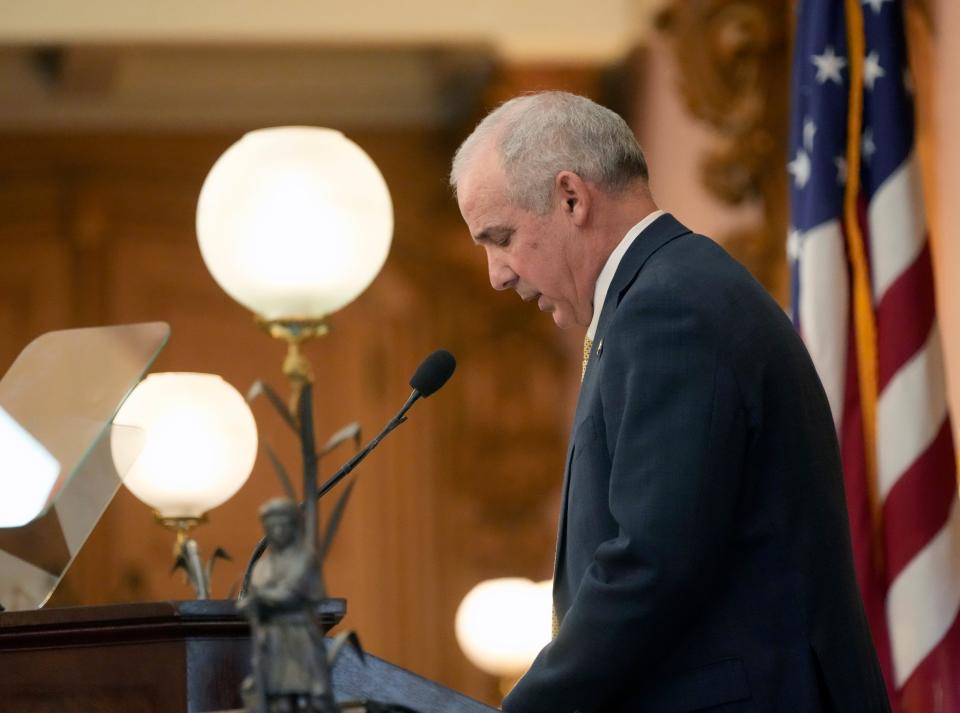Gov. Mike DeWine focuses on education, mental health in State of the State address
- Oops!Something went wrong.Please try again later.
Gov. Mike DeWine laid out the first budget of his second term in office on Tuesday, centering much of his agenda around education and how to improve the well-being of children and families.
"It is a budget that focuses on our people, on our families, and on our children, for they are Ohio’s greatest asset," DeWine told state lawmakers and other officials gathered at the Statehouse. "It reflects our obligation to make sure every Ohioan has the tools to succeed, to get a good job, to live their dreams, whatever they may be."
Here's what the governor is proposing for Ohio's next two-year budget:
K-12 Education
The governor started his speech by saying Ohio has a “moral imperative to see that all Ohioans are fully educated.”
The first item on his agenda was literacy. Forty percent of Ohio’s third-grade students are not proficient in reading, according to data from the Ohio Department of Education.
DeWine's budget tasks the Ohio Department of Education with crafting a plan to provide all students with access to evidence-based curriculum that improves literacy. He also directed funds to help charter schools pay for professional development and curriculum materials on literacy.
And he asked lawmakers to cover the costs of a school resource officer for every public and private school that wants one.
“We also want to do this because, oftentimes, there is a trust that gets built between students and the officer that would not otherwise occur but for that officer being in the school each day,” DeWine said.
When it came to funding public education, DeWine wants to continue implementing the new school funding formula from his last budget.
DeWine also wants to expand school choice by increasing the income eligibility for EdChoice scholarships up to 400% of the federal poverty level. That’s $111,000 per year for a family of four.
This expansion of school vouchers would cost about $178 million per year, according to an analysis from the Legislative Services Commission.

Mental health
DeWine's budget outlined several proposals aimed at boosting mental health resources, with the goal of reducing suicide and addiction in Ohio.
“We must face the fact that no Ohioan will ever fully live up to their potential or be able to lead purposeful and meaningful lives if their mental illness remains in the shadows and untreated,” he said.
DeWine wants to expand the availability of counseling services, both in-person and telehealth, and tackle workforce shortages in the behavioral health field. He also called on lawmakers to invest more in pediatric behavioral health care and crisis response resources, including the new 988 suicide hotline.
But he said the state must also do more to address the root causes of mental illness and learn “why so many of our fellow Ohioans keep falling into that proverbial river.”
To that end, DeWine announced the creation of the State of Ohio Action for Resiliency, or SOAR, Network. The program aims to bring together doctors, counselors, social workers and other stakeholders to increase research and determine what treatments could improve outcomes.
Infants and younger children
To help families with young children, DeWine proposed ending state sales taxes on “critical infant supplies” like diapers, wipes, cribs, car seats, strollers and other safety equipment. He also wants to the Legislature to enact a $2,500 per child state tax deduction.
He also called for the creation of a new statewide agency called the Department of Children and Youth. The idea is to consolidate programs from six different state agencies and focus on physical health, behavioral health, children in foster care and early childhood education.
Career and college education
DeWine called for a one-time investment of $300 million to fund capital improvements and equipment for career tech education.
He got a standing ovation from lawmakers for his proposal to give $5,000 per year scholarships to any Ohio high school student who graduates in the top 5% of their class and chooses to attend an in-state college or university.

Law enforcement
DeWine proposed $40 million per year to train officers on issues ranging from de-escalation to use-of-force crisis intervention for someone with a mental illness. He also wants to spend more on body cameras for police departments.
"Recent events have once again shown us how important body camera footage can be, as well as the critical need for on-going training for our law enforcement officers," DeWine said, referring to the recent beating of Tyre Nichols by Memphis police.
Jobs and economic development
DeWine lauded a number of economic development projects that have landed in Ohio, including Intel’s semiconductor plant in Licking County. But he said several companies gravitated toward central Ohio because other areas didn’t have the infrastructure to support large-scale projects.
“We simply don’t have enough shovel-ready, development-ready sites for the kind of calls we are getting from companies all over the world,” he said.
The governor wants to change that by spending $2.5 billion to boost infrastructure for economic development sites across the state. He also wants to use another $150 million to increase innovation hubs, which partner with universities to attract talent and create jobs.
Affordable housing
Lower rates of construction and rising cost of homes, especially around Ohio’s major cities, have made it harder for families to buy their first home.
“This has put a strain on our housing market, especially affecting Ohioans with low and moderate incomes,” DeWine said.
He proposed a combination of tax changes and new programs to help encourage the construction of housing for lower-income families.
These include low income housing tax credits, single family housing tax credits, and a new program inside the treasurer’s office called the Ohio Home Ownership savings account to help people save for a down payment.

What happens next?
DeWine's budget is just the first step. Lawmakers will haggle over the 2024-2025 spending plan in the coming months and must approve a final product by June 30.

Senate President Matt Huffman, R-Lima, said he was encouraged by DeWine's proposal, including plans to make it easier for Ohioans to have children. At the same time, he wants to ensure lawmakers don't spend too much money that could burden state government in the long term. Some of DeWine's proposals would be covered by one-time federal pandemic funds.
Huffman expressed skepticism about DeWine's plan to fund schools, the same concerns he had in the state's previous budget. But he was enthusiastic about expanding access to school vouchers, something the Senate president has been pushing for since he got to the legislature.
Huffman also signaled that lawmakers will look at ways to further cut Ohio's income tax brackets, something new House Speaker Jason Stephens, R-Kitts Hill, supports.
The last three state budgets have "flattened" the number of income tax rates down to three. These are the percentages you pay in taxes based on how much you earn. Currently, Ohioans pay nothing on the first $25,000 they earn, and then there are three steps to the top tier that starts at $110,651 annually.
Democrats, meanwhile, embraced some of DeWine's plans to invest in technical education and tackle the state's high infant and maternal mortality rates. But they said the final product should go further in addressing other concerns, such as comprehensive health care and public transportation.
For them, the devil will be in the details.
"We seek a budget that works for everyone, a budget that puts the people first," Senate Minority Leader Nickie Antonio, D-Lakewood, said. "We need a budget that will create ladders of opportunity and pathways to success for all Ohioans, especially our children, not just tax cuts for the most wealthy."
Haley BeMiller and Anna Staver are reporters for the USA TODAY Network Ohio Bureau, which serves the Columbus Dispatch, Cincinnati Enquirer, Akron Beacon Journal and 18 other affiliated news organizations across Ohio.
Get more political analysis by listening to the Ohio Politics Explained podcast
This article originally appeared on The Columbus Dispatch: Ohio Gov. Mike DeWine delivers State of the State address

